Choosing Natural Sweeteners
"The best source of sugar is always from whole food fruits and vegetables."
Irini
The Body Healer |
Sugar in its natural form is a simple carbohydrate that occurs naturally in foods such as fruits, vegetables, grains, legumes, and grasses (sugar cane). When these foods are eaten in their whole state such as in fruits, veggies, raw sprouted grains, and sugar cane, they have not been extracted, processed, and refined.
These natural carbohydrates are accompanied by thousands of other nutrients, including vitamins, minerals, fiber, enzymes, and phytochemicals. These nutrients work together synergistically during digestion and assimilation, which is why the best source of sugar is always from whole food fruits and vegetables.
From a health perspective, it is the naturally occurring sugars in whole foods that the body was built to assimilate, not the ones in processed foods or the ones artificially created in the lab.
Why you should avoid artificial sweeteners...
Natural Sweeteners
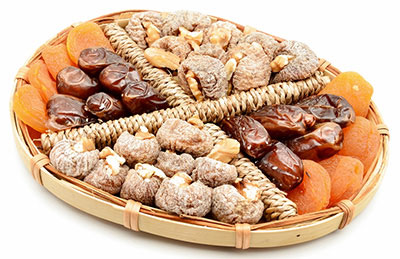 When choosing natural sweeteners, head first for whole food sources such as fruits, dates, figs, and coconuts.
When choosing natural sweeteners, head first for whole food sources such as fruits, dates, figs, and coconuts.
Natural sweeteners also come in a highly concentrated form, such as agave nectar, coconut sugar, honey, maple sugar, maple syrup, and stevia. Even though they are natural, in large quantities, they can interfere with our appetite control leading to sugar cravings, promote insulin resistance, and cause us to gain weight. Concentrated sweeteners contribute to blood sugar disorders because they are concentrated far beyond what the human body was adapted to metabolize at one sitting. Just because it is "natural" does not make it a Holy Grail for sweetness.
When using sweeteners, always remember that when you take a whole food and then extract and isolate compounds from it, it is no longer the same product. It can no longer function as it did when it was part of the whole plant. For example, a vitamin C pill can never be compared to the vitamin C in an orange, which interacts with a symphony of thousands of other micronutrients. If you take vitamin C supplements daily, reconsider that choice. Studies have shown that synthetic vitamin C supplements fare little better than a placebo, and do NOT produce the same protective qualities in the body as when eaten with the accompanying protective factors from whole foods.
When it comes to supplements, over 90% of them are synthetic. Not only that, once a nutrient has been isolated, they function differently to the original nutrient, and some synthetic supplements (e.g. folic acid - the synthetic version of folate) do you more harm than good.
Agave Nectar
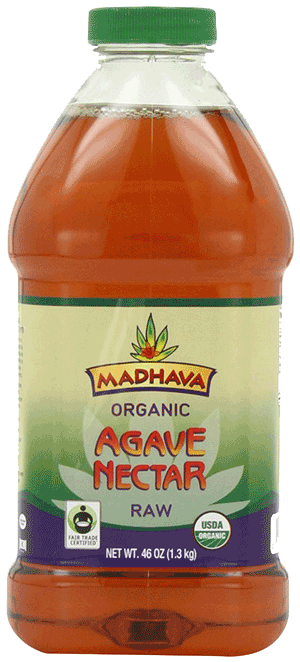
A succulent plant native to Mexico, the nectar is found in the center of the plant. It is extracted, filtered, heated, and hydrolyzed into the bottled agave syrup. Agave is very sweet, and has a very liquidy texture. Even though it is sweeter than other sweeteners, it ranks relative low glycemic on the index due to its low glucose content. The fructose content can vary considerably (from 90% to 55%), depending on the processing.
When purchasing agave nectar products, pay close attention to the label. The ingredient "agave inulin" is not agave. It is a highly processed fiber derivative from the blue agave plant.
Agave syrup
Unlike sweeteners such as honey and date sugar, agave syrup is not a product found in nature and has to undergo heavy processing to be turned into agave syrup.
In Cooking
In recipes, 1 cup sugar = 2/3 cup agave
Lower the oven temperature 25°F
...Click here to purchase
Brown Rice Syrup
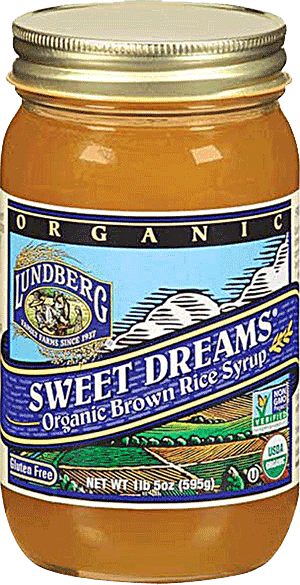
Brown rice syrup is made from white rice, yet results in a brown syrup. The rice is cooked and cultured with enzymes that help break down the starch to maltose. It is not as sweet as sugar and tastes similar to butterscotch. It is also broken down more slowly in the bloodstream, creating less dramatic spikes in blood glucose.
In Cooking
In recipes, 1 cup sugar = 1.25 cup brown rice syrup
Lower the oven temperature 25°F
For each cup, reduce liquids by 2 tbsp
Helps make food crispier and harder (e.g. crunchy cookies, rice crispy type treats, and granolas).
...Click here to purchase
Coconut Sugar/Coconut Palm Sugar
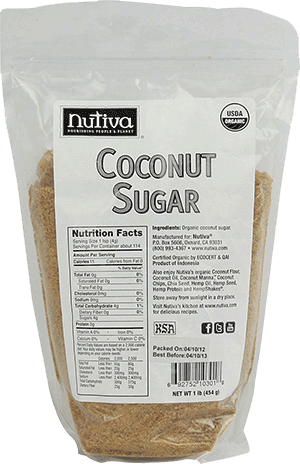
Also known as coconut palm sugar, coconut sugar is produced by evaporating the sap of the flower buds of the coconut palm tree, reducing the sap to granules. It can also be sold in paste form. Coconut sugar is brown in color and has a rich flavor, however it does not taste at all like coconut. It has a lower glycemic index (35) than table sugar.
In Cooking
In recipes, coconut sugar replaces sugar 1:1
...Click here to purchase
Date Sugar
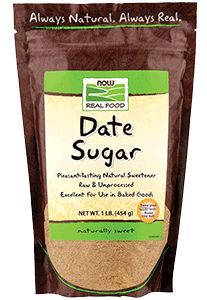
Dehydrated dates are finely ground to produce a granulated sugar. Date sugar has a rich date taste and contains all the vitamins, minerals, and fiber content of dates. Sprinkled on top of oats or cream of wheat, it makes a wonderful sugar replacement. It is, however, quite sticky.
In Cooking
In recipes, date sugar replaces sugar 1:1
Does not melt very well and burns easily.
Not recommended for cooked recipes.
...Click here to purchase
Honey
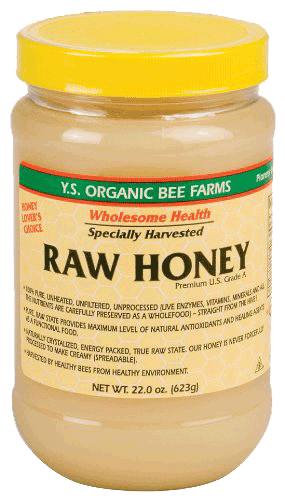
Honey is the oldest of the natural sweeteners and is made by bees from the nectar of flowers. Depending on the flower that the honey was produced from, it can have a wide range of flavors and colors. Sunflower honey, for example, is a pale yellow color and is softer and easier to spread as compared to the dark amber of macadamia honey.
Always purchase "raw honey" as the enzymes, vitamins, and minerals are all still intact. Many "fake" honeys are now on the market, which barely resemble real honey at all.
In Cooking
In recipes, 1 cup sugar = 3/4 cup honey
Lower the oven temperature 25°F
For each cup of honey, reduce liquids by 2 tbsp
...Click here to purchase
Maple Syrup/Sugar
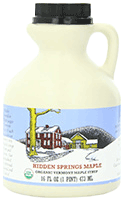
Maple syrup comes from the sap of maple tree species such as the sugar maple, red maple, or black maple. The maple is collected, filtered, and boiled down to an extremely sweet syrup with a distinctive flavor. It is high in mineral content (manganese and zinc) and contains less calories than other sweeteners. The maple provides a very rich and pleasant "mapley" flavor to baking.
When choosing which maple syrup product to purchase, keep two important things in mind:
- Imitation Maple Syrup
Avoid imitation maple syrups, labeled as "maple-flavored syrups," which contain high-fructose corn syrup and/or other artificial sweeteners. To easily tell the difference, check out the ingredient list and make sure it contains 1 item only: Maple syrup!
- Grade A or Grade B?
Maple syrup is sold in the USA as either Grade A or Grade B. Contrary to popular belief, both grades of maple syrup contain many beneficial nutrients. The difference is due to when the maple is harvested. As the spring warms up, the sap coming from the trees becomes darker in color, producing a darker syrup. All grades of pure maple syrup are identical in maple sugar content (66.9%), but the color of the syrup can range from pale gold to dark brown. The darker the syrup is, the stronger its flavor. Grade B is darker, thicker, and has a more intense caramel flavor than Grade A. Grade B maple syrup is usually made at the end of the sugaring season, just before the maple trees bud.
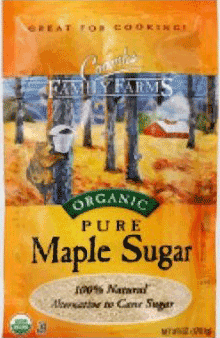 In Cooking
In Cooking
In recipes, 1 cup sugar = 3/4 cup maple syrup
Lower the oven temperature 25°F
For each cup of maple syrup, reduce liquids by 2 tbsp
...Click here to purchase Grade B maple syrup
...Click here to purchase maple sugar
Molasses
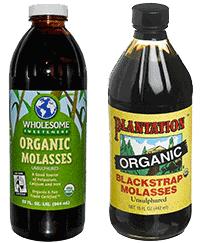
In its organic form, molasses this is a highly nutritious sweetener and is typically derived from either sugar cane or sugar beet. The longer the juice is boiled, the less sweet and darker it becomes. Molasses as a very strong and distinct flavor and is safe for most glucose or blood sugar level issues. Ironically, even though molasses is one of the best forms of natural sweetener, in the food processing industry, it is treated as a "waste by-product" of making sugar cane or sugar beet into table sugar.
There are three grades of molasses:
- Sulphured
- Unsulphured (...Click to purchase)
- Blackstrap (...Click to purchase)
Unsulphured is a better choice as the sulphur used to process the sugar cane is not great for human consumption. Blackstrap molasses is the thickest and most nutritious variety. It is a great source of iron, potassium, calcium, and magnesium. When buying, consider choosing organic blackstrap molasses, as pesticides are more likely to be very concentrated due to how the molasses is produced.
Rapadura (Whole Sugar Cane)
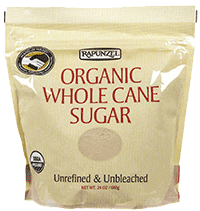
Rapadura is the Portuguese name for unrefined dried sugar cane juice. This is a brand-name product made from extracting juice from the sugar cane plant, evaporating water from the juice, and then grinding the resulting mixture into a powder. Because it is unrefined, the only thing that has been removed from the original sugar cane juice is the water. It still contains all of the vitamins and minerals that are normally found in sugar cane juice.
Rapadura is brown in color, similar to brown sugar.
In Cooking
Rapadura replaces sugar 1:1
...Click here to purchase
Stevia
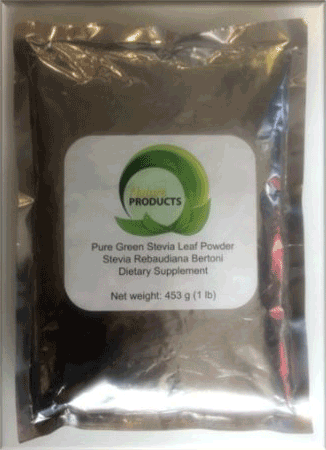
Used by Native Americans for centuries, the stevia plant can be used in powder or extract form as a sweetener. It is native to subtropical and tropical areas of North and South America, and South East Asia.
The sweet taste comes from the two steviol glycosides, stevioside and rebaudioside. Products can contain one or both of these glycosides. The extract is much sweeter than sugar (about 200-300 times sweeter) and should be used in very small quantities. Stevia has no calories and has no effect on our bodies' production of insulin.
NOTE: The only ingredient in your stevia product should be just that - stevia! But many stevia products contain other ingredients. Pay close attention to the ingredient label:
- Unrefined stevia is dark green in color. The white and clearer versions are refined.
- Check the label and make sure your stevia does not contain unnecessary ingredients such as dextrose, maltodextrin, or erythritol. These are naturally occurring sugars, but food manufacturers instead use GMO corn, which is then processed to create chemically pure erythritol.
- Avoid "natural flavors" which are often not natural and can contain a variety of chemicals that are completely unnecessary. The average "natural flavor" is a concoction of up to 50 chemicals.
- When choosing products already sweetened with stevia, look for “whole leaf stevia."
Nature Products is an example of one brand that offers pure green stevia on Amazon. Another great way to consume stevia is to simply purchase a stevia plant, dry out the leaves and grind them up into a spice jar. It is always better to use the whole plant and not just the extracts and isolated compounds.
In Cooking
Stevia can taste a little bitter in drinks and recipes
In recipes, 1 cup sugar = 1 tsp stevia
Oven temperature may or may not need changing - experiment
Add 1/8 cup water
...Click here to purchase
Sucanat (Sugar Cane Natural)
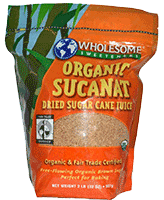
An abbreviation for "Sugar Cane Natural," sucanat consists of evaporated organic cane juice made through a mechanical rather than chemical process, which is then heated and cooled until tiny brown crystals form (due to the molasses content). This means that the resulting grainy product is much less refined and retains many of the sugar cane's original vitamins and minerals.
In Cooking
Sucanat replaces sugar 1:1 and is a great substitute for traditional brown sugar
Add 1/4 tsp baking soda
...Click here to purchase
Turbinado Sugar
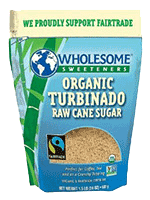
Similar to sucanat, the sugar cane is pressed to extract the juice, and the juice is then boiled, cooled, and allowed to crystallize into granules. It is then refined by washing it in a centrifuge to remove any impurities and surface molasses. Turbinado is lighter in color than sucanat, and contains less molasses than both rapadura and sucanat.
Even though it is called "sugar in the raw," some do not consider this a raw product due to the light refining.
In Cooking
In recipes, turbinado replaces sugar 1:1
Add 1/4 tsp baking soda
...Click here to purchase
Evaporated Cane Juice
Known as "unrefined sugar" in Europe, evaporated cane juice is a finer, lighter-colored version of turbinado sugar.
In Cooking
In recipes, evaporated cane juice replaces sugar 1:1
Vegetable Glycerine (Glycerine/Glycerol)
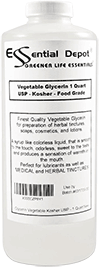
Also known as glycerin, or glycerol, vegetable glycerin is a colorless, odorless liquid made from coconut and palm oils. It is very sweet and has the consistency of a thick syrup. It is produced using an extraction processed called hydrolysis, where oils are placed under the combined force of pressure, temperature, and water. The glycerin is split from fatty acids and is absorbed by the water, and the resulting liquid is distilled for purity.
When used in foods, glycerin attracts water to help them stay moist, which is why it is also used in many household products such as shampoos, lotions, and toothpaste.
As it contains no sugar, glycerin is not metabolized like sugar and therefore does not cause a rise in blood sugar. It contains slightly more calories than sugar, yet is only about half as sweet.
In Cooking
Similar to sugar alcohols, too much glycerin can produce a laxative effect. It is also toxic in large quantities. For these reasons, it is not recommended to use as a cooking ingredient.
...Click here to purchase
Xylitol - the "Unnatural" Natural Product
Yes, our bodies naturally produce xylitol, but this is very different from the manufactured substance used as a sweetener in food products. Xylitol is derived from the crushed fibers of sugar cane using a multi-step chemical reaction that involves the use of sulfuric acid, calcium oxide, phosphoric acid, and activated charcoal. This forms a bleached, powdery blend of sugar alcohols that taste sweet but are not absorbed by the body. Being that xylitol is a natural substance that is then processed using man-made chemicals, the result is far from a natural product.
The FDA issued a warning stating that xylitol can kill pets such as dogs or ferrets.(1) In large amounts, xylitol can cause gastrointestinal discomfort and is considered a mild laxative.
Cooking With Sweeteners
A sweetener of some kind is one of the most widely used ingredients in cooking. If you need to add a sweetener to your recipes, then always use natural sweeteners. Use them in moderation and with the intent to reduce them in your diet. Let's take a look how to use some of the most common natural sweeteners in our cooking recipes.
With the exception of brown rice syrup, syrups work well for moist baked goods and will soften crispier baked goods. Experiment with these conversions, as they may vary from recipe to recipe (and when cooking at high altitude).
For every 1 cup of sugar called for in a recipe, use the following equivalents:
| Sweetener | | Amount | | Liquids | | Temp | | Notes |
| Coconut Sugar | | 1 cup | | | | | | |
|
| Agave Syrup | | 3/4 cup | | | | lower 25ºF | | |
|
| Honey | | 3/4 cup | | reduce 2 tbsp | | lower 25ºF | | |
|
| Maple Syrup | | 3/4 cup | | reduce 2 tbsp | | lower 25ºF | | add 1/4 tsp baking soda |
|
| Brown Rice Syrup | | 1.5 cups | | reduce 2 tbsp | | lower 25ºF | | great for crunchy food |
|
| Rapadura | | 1 cup | | | | | | |
|
| Stevia | | 1 tsp | | add 1/8 cup | | | | |
|
| Evap. Cane Sugar | | 1 cup | | | | | | |
|
| Vegetable Glycerin | | | | | | | | not recommended |
|
| Sucanat/Turbinado | | 1 cup | | | | | | add 1/4 tsp baking soda |
|
| Molasses | | varies | | | | | | |
|
RELATED ARTICLES
In this section...
In other sections...
View Sources & References
 When choosing natural sweeteners, head first for whole food sources such as fruits, dates, figs, and coconuts.
When choosing natural sweeteners, head first for whole food sources such as fruits, dates, figs, and coconuts. Learn more about natural vs. synthetic supplements:
Learn more about natural vs. synthetic supplements: A succulent plant native to Mexico, the nectar is found in the center of the plant. It is extracted, filtered, heated, and hydrolyzed into the bottled agave syrup. Agave is very sweet, and has a very liquidy texture. Even though it is sweeter than other sweeteners, it ranks relative low glycemic on the index due to its low glucose content. The fructose content can vary considerably (from 90% to 55%), depending on the processing.
A succulent plant native to Mexico, the nectar is found in the center of the plant. It is extracted, filtered, heated, and hydrolyzed into the bottled agave syrup. Agave is very sweet, and has a very liquidy texture. Even though it is sweeter than other sweeteners, it ranks relative low glycemic on the index due to its low glucose content. The fructose content can vary considerably (from 90% to 55%), depending on the processing. Brown rice syrup is made from white rice, yet results in a brown syrup. The rice is cooked and cultured with enzymes that help break down the starch to maltose. It is not as sweet as sugar and tastes similar to butterscotch. It is also broken down more slowly in the bloodstream, creating less dramatic spikes in blood glucose.
Brown rice syrup is made from white rice, yet results in a brown syrup. The rice is cooked and cultured with enzymes that help break down the starch to maltose. It is not as sweet as sugar and tastes similar to butterscotch. It is also broken down more slowly in the bloodstream, creating less dramatic spikes in blood glucose. Also known as coconut palm sugar, coconut sugar is produced by evaporating the sap of the flower buds of the coconut palm tree, reducing the sap to granules. It can also be sold in paste form. Coconut sugar is brown in color and has a rich flavor, however it does not taste at all like coconut. It has a lower glycemic index (35) than table sugar.
Also known as coconut palm sugar, coconut sugar is produced by evaporating the sap of the flower buds of the coconut palm tree, reducing the sap to granules. It can also be sold in paste form. Coconut sugar is brown in color and has a rich flavor, however it does not taste at all like coconut. It has a lower glycemic index (35) than table sugar.  Dehydrated dates are finely ground to produce a granulated sugar. Date sugar has a rich date taste and contains all the vitamins, minerals, and fiber content of dates. Sprinkled on top of oats or cream of wheat, it makes a wonderful sugar replacement. It is, however, quite sticky.
Dehydrated dates are finely ground to produce a granulated sugar. Date sugar has a rich date taste and contains all the vitamins, minerals, and fiber content of dates. Sprinkled on top of oats or cream of wheat, it makes a wonderful sugar replacement. It is, however, quite sticky. Honey is the oldest of the natural sweeteners and is made by bees from the nectar of flowers. Depending on the flower that the honey was produced from, it can have a wide range of flavors and colors. Sunflower honey, for example, is a pale yellow color and is softer and easier to spread as compared to the dark amber of macadamia honey.
Honey is the oldest of the natural sweeteners and is made by bees from the nectar of flowers. Depending on the flower that the honey was produced from, it can have a wide range of flavors and colors. Sunflower honey, for example, is a pale yellow color and is softer and easier to spread as compared to the dark amber of macadamia honey.  Maple syrup comes from the sap of maple tree species such as the sugar maple, red maple, or black maple. The maple is collected, filtered, and boiled down to an extremely sweet syrup with a distinctive flavor. It is high in mineral content (manganese and zinc) and contains less calories than other sweeteners. The maple provides a very rich and pleasant "mapley" flavor to baking.
Maple syrup comes from the sap of maple tree species such as the sugar maple, red maple, or black maple. The maple is collected, filtered, and boiled down to an extremely sweet syrup with a distinctive flavor. It is high in mineral content (manganese and zinc) and contains less calories than other sweeteners. The maple provides a very rich and pleasant "mapley" flavor to baking.
 In its organic form, molasses this is a highly nutritious sweetener and is typically derived from either sugar cane or sugar beet. The longer the juice is boiled, the less sweet and darker it becomes. Molasses as a very strong and distinct flavor and is safe for most glucose or blood sugar level issues. Ironically, even though molasses is one of the best forms of natural sweetener, in the food processing industry, it is treated as a "waste by-product" of making sugar cane or sugar beet into table sugar.
In its organic form, molasses this is a highly nutritious sweetener and is typically derived from either sugar cane or sugar beet. The longer the juice is boiled, the less sweet and darker it becomes. Molasses as a very strong and distinct flavor and is safe for most glucose or blood sugar level issues. Ironically, even though molasses is one of the best forms of natural sweetener, in the food processing industry, it is treated as a "waste by-product" of making sugar cane or sugar beet into table sugar. Rapadura is the Portuguese name for unrefined dried sugar cane juice. This is a brand-name product made from extracting juice from the sugar cane plant, evaporating water from the juice, and then grinding the resulting mixture into a powder. Because it is unrefined, the only thing that has been removed from the original sugar cane juice is the water. It still contains all of the vitamins and minerals that are normally found in sugar cane juice.
Rapadura is the Portuguese name for unrefined dried sugar cane juice. This is a brand-name product made from extracting juice from the sugar cane plant, evaporating water from the juice, and then grinding the resulting mixture into a powder. Because it is unrefined, the only thing that has been removed from the original sugar cane juice is the water. It still contains all of the vitamins and minerals that are normally found in sugar cane juice.  Used by Native Americans for centuries, the stevia plant can be used in powder or extract form as a sweetener. It is native to subtropical and tropical areas of North and South America, and South East Asia.
Used by Native Americans for centuries, the stevia plant can be used in powder or extract form as a sweetener. It is native to subtropical and tropical areas of North and South America, and South East Asia. An abbreviation for "Sugar Cane Natural," sucanat consists of evaporated organic cane juice made through a mechanical rather than chemical process, which is then heated and cooled until tiny brown crystals form (due to the molasses content). This means that the resulting grainy product is much less refined and retains many of the sugar cane's original vitamins and minerals.
An abbreviation for "Sugar Cane Natural," sucanat consists of evaporated organic cane juice made through a mechanical rather than chemical process, which is then heated and cooled until tiny brown crystals form (due to the molasses content). This means that the resulting grainy product is much less refined and retains many of the sugar cane's original vitamins and minerals. Similar to sucanat, the sugar cane is pressed to extract the juice, and the juice is then boiled, cooled, and allowed to crystallize into granules. It is then refined by washing it in a centrifuge to remove any impurities and surface molasses. Turbinado is lighter in color than sucanat, and contains less molasses than both rapadura and sucanat.
Similar to sucanat, the sugar cane is pressed to extract the juice, and the juice is then boiled, cooled, and allowed to crystallize into granules. It is then refined by washing it in a centrifuge to remove any impurities and surface molasses. Turbinado is lighter in color than sucanat, and contains less molasses than both rapadura and sucanat.  Also known as glycerin, or glycerol, vegetable glycerin is a colorless, odorless liquid made from coconut and palm oils. It is very sweet and has the consistency of a thick syrup. It is produced using an extraction processed called hydrolysis, where oils are placed under the combined force of pressure, temperature, and water. The glycerin is split from fatty acids and is absorbed by the water, and the resulting liquid is distilled for purity.
Also known as glycerin, or glycerol, vegetable glycerin is a colorless, odorless liquid made from coconut and palm oils. It is very sweet and has the consistency of a thick syrup. It is produced using an extraction processed called hydrolysis, where oils are placed under the combined force of pressure, temperature, and water. The glycerin is split from fatty acids and is absorbed by the water, and the resulting liquid is distilled for purity.